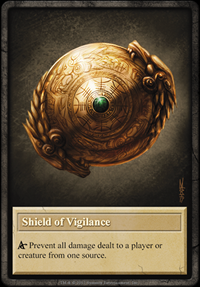
Welcome to the first article for Summonology – our new blog featuring thoughts on Summon’s games, future projects, and game design in general. In this inaugural post we'll take a look at some of the powerful new cards arriving with Epic Roll: Eclipse.
We're all familiar with Epic Roll's Reward Cards ("treasure cards" in the first printing) - those lovable Hits, Heals, and Blocks that keep our champions battling onward, despite the violent appetites of ghouls and zombies. And who can forget the trusty Counter, with its endearing ability to drain all hope from your opponent's eyes?
There are some amazing reward cards coming in Epic Roll: Eclipse as well, but today I'm excited to talk about the new cards on the block - Relics.
Eclipse includes a set of eight Relic cards, featuring outstanding illustrations by Mari Takeyama, and graphical design by Big Kev (a.k.a. our art director, Kevin Toft). Relics bring a new facet to Epic Roll games - namely, the opportunity to customize your champion, and develop a strategy before the dice start flying. And while the relics are part of Eclipse, they plug right in while playing the original Epic Roll, and shine even brighter when both sets are played together. I'll go over the rules for including relics in your games, and talk a bit about one relic in particular - the Shield of Vigilance.
If you dig Epic Roll and you’re looking forward to Eclipse, we’d love it if you could rate us on BoardGameGeek - or even add yourself as a Fan or contribute a short review if you’re so inclined! Who better to spread the word than our highly intelligent, strikingly handsome players :)
Links for the Link God:
Choosing Relics
Once players choose or draw their champions, shuffle the relic deck. Two relic cards are drawn and placed face-down on the table, along with an additional card for each player participating in the game (example - five relic cards would be drawn for a three player game). The cards drawn are the available relics for this game – any remaining cards are placed off to the side, and cannot be looked at or used.
Designer Note - creating a limited subset of cards for each game allows popular cards in your group to have a little time off now and then, and helps to keep "analysis paralysis" in check among newer players - particularly important when more relics are added in future set.
Relics are then drafted in reverse-turn order (bottom-to-top on the board). Each player looks at the available relics, chooses one, and passes the remaining cards to the next player. Once every player has chosen a relic, the two remaining cards are set aside with the other unused relics (again, no peeking). Players set their relic face-down beside their champion card.
Revealing and Using Relics
Relics are kept hidden until the beginning of the controlling player's first turn, at which point they’re flipped face up. Once revealed, the relic’s abilities are available for use. Relics each possess at least one ability (active or passive). Relics must be activated (turning the card to the spent position) to use an active ability. Just like champion cards, relics are returned to the ready position at the beginning of their controller's turn.

The Shield of Vigilance
The Shield of Vigilance (SOV) is a potent and flexible defensive item, and we’ve found it very popular among our beta testers and internal play group. The SOV can be activated to prevent damage to yourself or another player from a single source. The “source” is most often an enemy creature’s die, but might also be an opponent’s ability or a Bolt card. The SOV is basically a Block result, sitting quietly on the table waiting for a signal from its wielder. And, as if the Shield needed another selling point, it has two dragon heads engraved on in for intimidation purposes.
Because it can protect other players, the SOV is a great choice in a team game – provided you don't mind being generous with its defense, rather than saving it for your own turn. The Shield can even be activated during an opponent’s turn to prevent damage to a creature they’re battling(!) Nothing says “I want to watch you fail” quite like blocking an opponent’s Critical Hit against a Templar or the Paladin King.
Feedback from testers identifies the Shield of Vigilance as a top pick for champions with little or no defense on their own die (Greff, Orric, and Goramoth being prime examples). It’s also a great choice for any player planning to support their allies in a team game, using reward cards and abilities to protect their comrades and propel them to victory. Finally, the SOV is definitely worth picking up if you enjoy shouting “SHIELD OF VIGILANCE!” at your friends while making baller plays to win games. And honestly, who doesn’t like that?
- Matt
